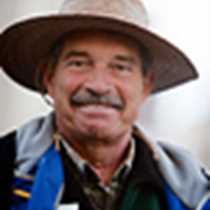Saginaw Bay and Chatham Strait
In Alaska, we can be shown every type of weather in a day (well, almost). Today we sailed into Saginaw Bay on Kuiu Island. A large number of birds were feeding in those waters, as well as a good number of jellyfish, Aurelia, small, white, with short tentacles, and the lion’s mane, large, brown/orange, with long, thin, tendrilous tentacles that can send you to the hospital! It is a long bay, and very soon we had spotted a bear, then another, and another. The sun warmed us up after two days of gray weather, and we absorbed the rays with gusto. After breakfast we were ready to disembark and go onto the beach, which is so interesting. Calcareous cliffs are not common in Southeast Alaska, and these contained a great amount of fossil brachiopods, different mollusks, and even large foraminifera, called fusulinids. These animals lived in the tropical seas where they were included in calcium carbonate many millions of years ago. A series of interesting plants hung precariously on the cliff face, including common juniper trees (very small and weed-sized), kinnickinnick, saxifrages, many ferns and mosses. But the plants that attracted our attention because of their delicate nature were the harebells, or bluebells. Moving softly in the wind, they were a very different color than even the red paintbrush! And, crawling among all these plants, and bedecked with the same colors as the lichens on the wall were dozens of small silverfish, partaking in the bounty of food hanging off that cliff wall.
Later in the afternoon, as we sailed north along Chatham Strait, we encountered a group of six or seven humpback whales feeding in a group. They would come up to the surface with gaping mouths and then breathe! This behavior we watched during at least half an hour!
In Alaska, we can be shown every type of weather in a day (well, almost). Today we sailed into Saginaw Bay on Kuiu Island. A large number of birds were feeding in those waters, as well as a good number of jellyfish, Aurelia, small, white, with short tentacles, and the lion’s mane, large, brown/orange, with long, thin, tendrilous tentacles that can send you to the hospital! It is a long bay, and very soon we had spotted a bear, then another, and another. The sun warmed us up after two days of gray weather, and we absorbed the rays with gusto. After breakfast we were ready to disembark and go onto the beach, which is so interesting. Calcareous cliffs are not common in Southeast Alaska, and these contained a great amount of fossil brachiopods, different mollusks, and even large foraminifera, called fusulinids. These animals lived in the tropical seas where they were included in calcium carbonate many millions of years ago. A series of interesting plants hung precariously on the cliff face, including common juniper trees (very small and weed-sized), kinnickinnick, saxifrages, many ferns and mosses. But the plants that attracted our attention because of their delicate nature were the harebells, or bluebells. Moving softly in the wind, they were a very different color than even the red paintbrush! And, crawling among all these plants, and bedecked with the same colors as the lichens on the wall were dozens of small silverfish, partaking in the bounty of food hanging off that cliff wall.
Later in the afternoon, as we sailed north along Chatham Strait, we encountered a group of six or seven humpback whales feeding in a group. They would come up to the surface with gaping mouths and then breathe! This behavior we watched during at least half an hour!




